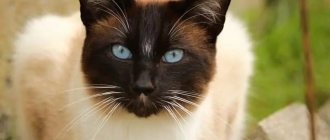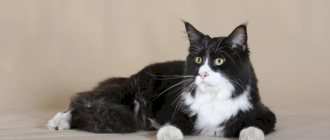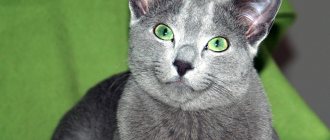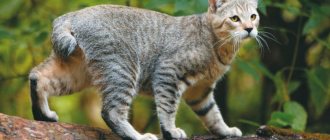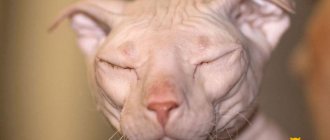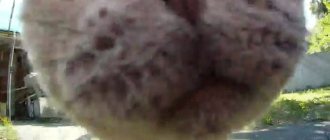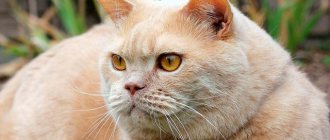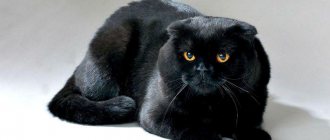Colors of Siamese cats with photos
There are more than 20 varieties of Siamese cat colors.
The most famous colors of Siamese cats are as follows:
- Seal point (brown) is a cream color that can have shades to light brown. The points of this color are dark brown.
- Blue point (blue) is a snow-white color with a bluish tint to the points.
- Red point – white body, red (apricot) point. There may be streaks on the markings, which is not an abnormality.
- Caramel point (light cream). This color is slightly different from the traditional one, since the cat is neither white nor brown. Its color is a magnolia shade, and its points are gray-pink.
- Chocolate point (black). The body is ivory in color, and the markings can range from chocolate (café au lait) to black.
- Cinnamon point (ivory shade). The cat's body is ivory-colored, like a "chocolate" point, but the markings are pinkish-brown.
- Lilac point (pink). The cat's body is the color of beaten egg white, and the markings are light gray with pink tints.
- The Torty Point is a rather unusual color, distinguished by a colored mask and the same markings on the paws, tail and ears.
- The Tabby Point is distinguished by the fact that the markings have stripes. The body is pale, without shades (plain color).
Features of color
A black and white cat is a pet, the color of which can be completely different. The combination of these two colors in the fur of a domestic cat often creates a funny ensemble, sometimes creating symmetry and sometimes asymmetry in color. The following features of such contrasting fur of pets can be distinguished:
- this color is purely individual; it is extremely rare to find two black and white kittens with the same arrangement of spots or streaks;
- Based on the first feature, breeding perfectly symmetrically colored black and white cats is particularly difficult, because of this the price of breeds with symmetrical black and white patterns on the coat is quite high;
- usually one of the two colors dominates the color, while spots or certain areas of the cat’s body are painted in another color, contrasting with the first;
- black and white breeds are interesting because different pigments can be present not only in the coat, but also on the paw pads, some of which can be colored pink, and some black;
- Most often, black and white kittens have eyes with green irises, like most black cats; but white breeds are characterized by blue eyes, therefore, among two-color representatives, a phenomenon such as heterochromia can occur - on the half of the muzzle that is dark-colored, the eye has a green tone, and on the white part of the muzzle there is a blue eye.
We can distinguish certain types of black and white colors that are characteristic of domestic felines.
Van is a color type characterized by the dominance of white. It covers most of the animal's body. Black fur may completely cover the tail, while there may be a few black spots on the face in the area above the eyes or near the ears. A small dark spot may also be present on the side or paw of the animal, in the shoulder area. Similarly colored cats are very popular exhibitors.
The above-mentioned varieties of black and white colors are the main ones. But, besides them, there is also such an option as the raincoat type. In a cat with this color of fur, black is located in the upper part of the body and head, resembling a cloak with a hood. The Cap and Saddle type is considered a fun color.
How much does a Siamese kitten cost?
The average price for a Siamese kitten is 8,000 – 35,000 rubles (5,000 – 10,000 UAH).
What does the price depend on?
Price formation is influenced by:
- kitten class;
- floor;
- colors;
- age;
- prestige of the nursery;
- parents' titles;
- sale with or without breeding rights;
- pedigree.
The biggest influence on the cost is belonging to a certain class:
- SHOW (show) – kittens are sold with the right to breed and are allowed to participate in exhibitions and competitions. Price: from 25,000 to 45,000 rubles;
- BREED - healthy kittens without genetic pathologies and good characteristics, have minor deviations from the standard, can be exhibited and allowed for breeding. They cost from 10,000 to 15,000 rubles.
- PET (pet) - pets without the right to breed, are not allowed to exhibitions. Price: from 3,000 to 10,000 rubles.
Character of Siamese cats
There is an opinion that all Siamese cats have an unbalanced character, are touchy, vindictive and simply aggressive. Breeders who have been working with the breed for many years are confident that such words are unfair. Yes, these are quite capricious and demanding pets, so they should not be owned by people who dream of an easygoing companion who will behave as quietly as possible.
For Siamese, communication is as vital a necessity as food and water. And it’s not just about playing together and affection! They literally talk to the owner, using a loud voice and expressive intonations, reporting everything they like or don’t like, are interested in, worry about, or irritate. After being separated for several hours, a detailed “report” about what happened during the day will be waiting for you, and your pet, of course, expects a response to his tirades; he will be happy to support the conversation.
By the way, Siamese cats are very sensitive to emotions expressed in human speech, they are offended by an angry, rude tone, so do not raise your voice unless necessary - it has long been proven that animals can also experience depression, which leads to negative consequences for physical health.
Siamese cats are attached to their family members, do not like loneliness, and will readily accompany you while moving around the apartment and “help” with household chores. And when you finally settle down in a chair with a laptop or a book, they will gently snuggle against your warm side and purr with pleasure.
Impressionable royals are not so patient as to constantly communicate with children under the age of 6-7 years, who do not understand the boundaries of personal space and, in their delight at the sight of a beautiful “kitty,” forget that a living creature cannot be treated as unceremoniously as a plush one. a toy. Siamese cats treat older children quite well.
As for other pets, no one can guarantee you peace and harmony in the house, although some Siamese make friends with dogs. If one pet is not enough for owners or they want to protect their furry family members from loneliness while everyone is at work, the best option would be to simultaneously purchase two Siamese kittens.
Description of the Siamese breed
Let's look at the appearance and character of Siamese according to the breed standard.
Standard
Siamese cats are well balanced, boasting an athletic, flexible body and elegant, slender legs.
The breed standard for the modern Siamese cat assumes:
- Body: Elongated, tubular and muscular. A typical Siamese cat has a total height of 20-25 cm and a body length of 29-36 cm, with a body weight of 4-5 kg.
- Head: Straight profile with a strong chin and a pleasant, even bite. The head forms a perfect triangle from the tip of the nose to each tip of the ear. The neck is long. The eyes are almond-shaped, bright blue, and the ears are large, wide, located closer to the head.
- Limbs: The cat's hind legs are longer than her front legs, which adds to her athletic and graceful appearance. The paws are oval shaped and small. Thin tail.
- Coat: Short, shiny, fine coat without undercoat that lies close to the body.
Today, there are over 20 varieties of Siamese cat colors all over the world, and the most famous of them are:
- Seal point (brown or cream), with a cream-colored body and dark brown pigments on the nose and paws. It is believed that this was the original color of the breed when it was first exported from Siam (Thailand).
- Blue Point (blue) - the body is snow-white with a bluish tint, as well as a gray nose and paws.
- The Red Point is a white body with red (apricot) pigments on the nose and paws.
- The Caramel Point (light cream) is considered a hybrid due to a complex breeding process, with very light and pink pigments on the nose and paws.
- Chocolate point (black). The body is cream or milky in color, and the pigments on the points can range from chocolate to black.
- Cinnamon point (ivory). The body is ivory-colored, like a Chocolate Point, but the markings on the nose and paws are pinkish-brown.
What breed can a three-haired cat be?
This coloration among representatives of the cat family is not associated with any specific breed. Both purebred and yard cats are variegated. The most common representatives of the following cat breeds with three shades of fur:
Aegean cat
Aegean cat. It is of indigenous origin and is a national treasure of Greece. This is the only natural breed of this country. Currently, it is not recognized by any felinological organization and belongs to the experimental group. Aegean cats are very rare. They are little known outside their homeland. Outwardly, these animals are similar to their stray counterparts, which can be found everywhere. What a typical representative of this breed looks like can be seen in the photograph.
Japanese Bobtail
Japanese Bobtail. The main feature is the shortened tail in the shape of a pompom. The homeland of these cats is Japan. Despite this, they began to be called that on the initiative of American felinologists. They come in short- and long-haired varieties. These cats are the prototypes of the world-famous maneki-neko mascots. It is believed that figurines of a well-fed cat with its paw raised in greeting bring good luck in money matters and attract business partners. It is noteworthy that the bobtail is able to hold its front leg in a relaxed state, freezing in this position for a long time. This cat's short tail is extremely sensitive.
Any careless touch to it causes severe pain to its owner. In the homeland of these animals, tricolored individuals are especially revered. On their snow-white fur they have black and red markings in a chaotic order.
This color is called mi-ke in Japan
On their snow-white fur they have black and red markings in a chaotic order. This color is called mi-ke in Japan.
Maine Coon
Maine Coon. It has an impressive size. The weight of these cats, originally from the USA, can reach up to 12 kg. They are considered one of the best types of family cats. They are unobtrusive, good-natured, moderately calm and get along well with children of any age.
Siberian cat
Siberian cat. One of the most popular Russian breeds. He is distinguished by his luxurious appearance, high intelligence, balanced character, devotion and excellent health. These rather large furry animals are considered long-lived - most of them live up to 18–20 years. One of the main advantages of these representatives of the cat family is the wide variety of colors, among which white and tricolor are especially valued.
“Three-colored cats” are also found among short-haired American, Persian and Norwegian forest cats, Turkish Vans, and Kurilian bobtails.
A tricolor kitten can be born to representatives of any breed. For example, “tricolors” are British cats of the “bicolor” color, resulting from a combination of white and tortoiseshell (i.e., black or blue with red or cream).
Conditions of detention
Siamese cats thrive both in the city and outside in the countryside. Without special need, these cats do not have the habit of running around the room, so they do not need a lot of space, and they will be quite happy living in a small apartment, where they need to create conditions for entertainment in the form of “climbing areas” specially designed for cats.
But since Siamese cats are considered descendants of hunting animals, the opportunity to hunt rodents on a private property will bring them great pleasure. Here they can play with family members and hunt small rodents and reptiles.
Did you know? Siamese cats can live up to 30 years, like the Siamese cat Scooter from the USA, born in 1986 and died in 2016. Although there is a known case where a Siamese cat died at the age of 38.
Caring for a Siamese kitten
It is simple due to the short hair and the love of cleanliness of animals of this breed; in addition to combing, take care of the eyes and ears by wiping them daily with a cotton pad soaked in Vaseline oil (for ear care) or in water (for the eyes).
The love of drinking (as opposed to swimming and water procedures) is in the blood of Siamese representatives; use a bowl with a wide bottom or a special automatic fountain drinker. Leave the food only in the amount that will be enough for one meal, wash the empty bowl with hot water before the next filling, and discuss regular food with your veterinarian. The tray also needs to be cleaned after the “hike”.
Siamese kittens are very popular and therefore widespread. If you are interested in the price, then Avito offers to buy kittens almost for nothing or free of charge “in good hands.” It is better to purchase a kitten with a pedigree from a nursery. Here their cost (based on data from Moscow nurseries) is from 15 to 25 thousand rubles, in the regions it is cheaper - 7-15 thousand.
Characteristics of the Scottish breed
Scottish Folds have one obvious difference - folded ears. It is impossible to confuse these cats with anyone else. There are other distinguishing characteristics of the breed that you should know.
Standard
Scottish Folds resemble the British cat, as they are their closest relatives. But there are still differences. The description of the appearance of a representative of the Scottish Fold breed is as follows:
- Body: medium size, slightly elongated, with voluminous breasts. The limbs are round and of medium length, sometimes long.
- Head: rounded, blends smoothly into the neck. They have pronounced cheeks and a round chin.
- Eyes: round, widely spaced. Eye color depends on coat color; there are no specific standards.
- Ears: the main distinguishing feature of the breed. Small in size, widely spaced and curved forward. They have one, two or three folds. The more folds, the more they are pressed to the head and more closely follow its shape.
- Coat: Scots are typically short, plush, with a thick undercoat. There are also long-haired cats of this breed. They are called Highland Folds.
- Weight: on average from 3 to 8 kg.
- Color: any color is allowed according to the standards.
A little more about colors. The following types are distinguished:
- solid - a shade of one tone, any color: black, white, blue (cold gray), chocolate, lilac, red;
- tortoiseshell - spots of more than 2 different shades, harmoniously located throughout the body or throughout the entire coat except the chest and paws;
- smoky – plain outer coat with a silvery-white undercoat;
- chinchilla - the base of the hair color is white, and the eighth part is colored;
- tabby - color with brindle, striped, spotted or marbled patterns;
- bicolor - a combination of white with blue, black or red, preferably white on the legs, paws, stomach, chest, chin and part of the face;
- van – the main coat color is white, the tail and two spots on the head are of a different color;
- harlequin - the main part of the coat is white, and a fifth of it is of a different shade;
- colorpoint - the shade of the entire coat is light, and the paws, tail, ears and muzzle are of a contrasting color.
Health
The life expectancy of Scottish cats is on average 12-15 years. They are quite strong animals. They have good health until old age, with proper care and nutrition. But since the breed was created using genetic mutations, this left its mark on the health of the offspring. Folds have some hereditary diseases:
- The most common is osteochondrodysplasia. This is a genetic disease of the musculoskeletal system that causes impaired growth of cartilage and bones or their deformation.
- Entropion of the eyelid, which is removed with surgery.
- The development of cataracts and glaucoma is possible.
- Ear infections.
- Partial or complete deafness.
- The risk of developing obesity due to unpretentiousness in food.
Character
Scottish Folds are cats that are suitable for almost any family. Easily adapt to new surroundings. They are not intrusive, calm, soft and peaceful animals. Of all the family members, they choose one favorite, which they consider their master. In his absence, they will be bored, and when he appears at home, they will follow on his heels.
These cats do not show aggression or too much activity. Scottish Folds divide their day into approximately 2 equal parts: active with games and exploration of the apartment, and sleep. The Scots like to lie down in some interesting position, for example, lying on their backs and spreading their paws. Or stand in the meerkat pose on your hind legs.
The Scots get along well with children. They will be able to steadfastly endure the attacks of their little owners, but this does not give children the right to mock the pet. You can simply rest assured for your child if he accidentally grabs or strokes the cat more than usual. The Scots react absolutely calmly to dogs. The Scots also have special sounds. They do not purr like ordinary cats, but make something similar to a quiet squeak.
Representatives of this breed are trainable. It's easy to teach them to go to the litter box. Due to their flexibility, they can easily master simple tricks. With the right amount of patience, you can teach a Scot to use the toilet as his toilet.
Interesting Facts
There are several interesting facts about black kittens with white paws and spots on their bodies. For example, the two-color color of cats was considered a defect for a long time, and only at the end of 1969 were they allowed to participate in exhibitions.
These animals are independent and self-sufficient, thanks to which they are able to survive without outside help. They are resistant to stressful situations and are never the first to show aggression. These animals love people and calmly get along with them under the same roof.
Black and white cats are unusually beautiful pets that are distinguished by their attractive two-tone color. People who want to get such pets should familiarize themselves with their main features and breeds in advance.
Any cats evoke associations with something mystical. Breeds of black cats are doubly mysterious. Although for only one variety of pets this color is the only acceptable one - Bombay.
Bombay cat
Character
Siamese, or Thai cats as they are also called, are considered the most intelligent and inquisitive cats. They are very curious, unpredictable and prone to jealousy. Siamese cats love to be close to their owner and will try to follow him everywhere. Many Siamese cats can be taught a variety of tricks if their owners are patient.
Siamese cats are playful, loving, loyal and affectionate animals. Their sociable nature requires constant interaction with humans, and since Siamese cats are very attached to their owners, it is better not to give them to people who cannot devote enough time to them.
Siamese cats are very energetic animals and if you want peace and tranquility in your home, it is better to choose another breed of cat.
Some owners of these cats believe that Siamese cats behave more like dogs than cats.
The talent of Siamese cats in communicating with humans is well known. Some people are annoyed by the loud voice of these cats, but lovers of this breed consider it a unique feature of Siamese cats. Indeed, Siamese cats are the most talkative breed of cats; you should not get such a cat if you think that the cat should not be heard.
Siamese cats are not a breed for everyone. But if you want a loving and sociable cat who is always on the move and hates being unnoticed, then the Siamese cat is a good fit for you.
Siamese cats usually make good family animals that are tolerant of not very young children (from the age of six) provided they are not rough with them. The relationship between Siamese cats and dogs depends on the individual dog and cat.
Temperament and eye color
Nature has endowed black cats with an easy-going and peaceful character. They are sincerely attached to a person and are able to capture his mood and state. It is blacks who are considered the best healers: they take negativity upon themselves, transform it into positive energy and return it to their owner. These animals are not characterized by aggression. Their playfulness and cheerfulness make them good playmates for children. If the owner often moves from place to place, they quickly adapt to new conditions.
The alarmed animal begins to rush around the house restlessly, forcing the owner to leave the building. However, black cats are loved not only for their friendly nature and colorful appearance, but also for the expressive look of their huge eyes. It has long been believed that the most common combination is a black cat with green eyes. Although genetic scientists tried so hard to breed an animal with an unusual iris color, today it is almost impossible to meet a cat with natural emerald green or grassy eyes.
Today's green color is one of the possible shades.
For example, almost all kittens are born with blue eyes. Then it all depends on the pigmentation. If the front of the eye is more pigmented, the cat will have yellow eyes. If the accumulation of pigment is in the back, you will get green eyes.
Main characteristics
Thanks to the unique coloring, the Siamese cannot be confused with other individuals. Pets have deep blue eyes and a rather intelligent and expressive look.
The weight of an adult cat is usually 4-5 kilograms. Animals that have undergone sterilization or castration can weigh 7-8 kilograms.
The height of cats is small and is 23-25 centimeters at the withers. The length of the body does not exceed 60 centimeters.
The color of these animals is unique. The main part of their body is light, and the tail, paws and muzzle are dark.
If you provide your cat with proper care and proper nutrition, its life expectancy can be 25 years.
The character of the Siamese cat is independent and stubborn. Cats are friendly towards both adults and children. They become very attached to their owner.
Siamese cats are very sensitive to the mood of their owner and can show jealousy towards him.
Despite the craving for loneliness, Siamese love cheerful company and are able to attract attention
Speaking about the character of the animal, it is worth mentioning its touchiness. Getting forgiveness from a punished or offended cat is not so easy.
Varieties of Siamese also include the Oriental, Mekong Bobtail and Thai Siamese.
Foreign white
This breed is the result of the painstaking work of its creators, whose goal was to obtain a Siamese cat of a snow-white color, without the presence of additional shades. Translated from English, the name of the cat sounds like “white foreigner.” She was officially registered as a representative of an independent breed in the second half of the last century. Another name for foreign white sounds like Chinese white. The main feature of the breed is that, despite its impeccable whiteness, all its representatives always have excellent hearing. Foreign White is a breed endowed with a strong mind. She loves to be the center of attention, gets along well with children and pets, but is also quite independent. Loves walks - this cat can easily be trained to walk on a leash.
Breeding Siamese cats
Puberty in this breed occurs at 5 months. But the ability to reproduce offspring appears only at 10 months (also depends on the time of year in which the animal was born) and ends at the 8th year of life.
It differs from other breeds in that the duration of pregnancy is on average 65 days (usually 55). Before the 68th day, the cat must give birth, otherwise it is believed that the kittens will be born post-term. In this case, it is necessary to involve a veterinarian.
During the first month of pregnancy, the cat's behavior changes. In addition, the cat gains excess weight, despite the fact that its appetite decreases. In the second month, the cat's belly becomes pear-shaped.
A week before giving birth, the pet may completely refuse food. The animal will seek affection and protection from the owner. A healthy cat can roll on its own. But it is better that the owner is nearby during childbirth. If necessary, you need to be ready to help the cat.
On average, a Siamese cat gives birth to 5–6 kittens. When kittens are born, the cat owner needs to ensure that the optimal temperature is maintained within 29°C at their location. This regime must be strictly followed for at least the first 3 days. Each subsequent week the temperature must be lowered by 3 degrees to reach a final temperature of 21°C.
Features of care and feeding
The Siamese cat does not require special care. Thanks to the short coat, owners are relieved of the need to constantly comb their pet and bathe it. Regularly monitor the condition of your eyes and teeth. Dried crusts are carefully removed from the corners of the eyes with a damp cloth. It is better to check the condition of your teeth periodically with a veterinarian to avoid problems. If necessary, trim your pet's nails with a special nail clipper. Purchase a scratching post so your cat can meet her claw sharpening needs. Your sofas and other furniture will be safe. Siamese are big clean people, so the litter box needs to be cleaned often, ideally immediately after relieving itself.
Feeding your cat must be taken with full responsibility, since its health depends on it. There are two types of nutrition: natural and dry food feeding. Natural feeding involves careful preparation of the diet and calculation of the necessary substances. At home, it is extremely difficult to provide a cat with the necessary substances, so many resort to feeding dry food.
Please note that only super premium dry food is suitable for this purpose! They cost from a thousand rubles for two kilograms (this weight is enough for a month). It is strictly forbidden to give your animal economy-class food, which is advertised in abundance on TV.
This is real poison! After purchasing a Siamese kitten, carefully study the issue of feeding; it is advisable to visit reputable communities where cat breeders can give you advice.
Description of the breed
Many people have a good idea of what magnificent representatives of Siamese cats look like. But, nevertheless, sometimes they are confused with Thais or Orientals
Therefore, it is important to know the essential points that distinguish Siamese
So, in the description of the Siamese cat breed, you should pay attention to:
- head and neck. They are always long. The muzzle is narrow and with a clear, straight nose. The chin is very well defined. The forehead is flat, although there are small bulges located in the area of the eyebrows. Another characteristic feature is that between the nose and the tips of the ears you can always mentally draw an equilateral triangle. Numerous photos of the Siamese cat confirm this fact;
- ears. Siamese are often called lop-eared. However, this is not at all surprising, since the size of their ears is large for such a small muzzle. The shape of the ears of these animals is triangular (sharp at the tips and wide at the base) and slightly set apart;
- eyes. They are especially important in the description of Siamese cats. They are distinguished by a beautiful almond-shaped shape, although not very large in size. As for the color, it is rich blue or green. By the way, blue eyes are sometimes slanted relative to the cat’s charming nose;
- tail and paws. Absolutely all the limbs of the Siamese look amazingly slender and long. Although the front legs are always slightly shorter than the hind legs. The tip of the tail is necessarily pointed, sometimes it is even compared to a whip (it’s not for nothing that the Thai princess was able to put her rings on it!);
- color A special feature of the Siamese cat breed is that it can have different colors, but all representatives must have so-called points. These are special markings on long legs, an amazing face, pointed tail and ears. They are usually darker than on the body. Their appearance is associated with different temperatures in the animal’s body: less pigment is produced in warmer parts, so the body is always lighter. Accordingly, a distinctive characteristic of the Siamese cat breed is that it can change color when it is cold (it becomes darker);
- body proportions. The Siamese is slender and muscular. All parts of his body are strictly proportional, which creates the impression of grace, elegance and grandeur. On average, the weight of a Siamese cat reaches 3-4 kilograms;
- wool. Siamese cats in the photo look incredibly beautiful and well-groomed. This is facilitated by the fact that their coat is shiny and short. It fits tightly to the body. There is no undercoat at all.
- life expectancy. Siamese, not without reason, are considered long-livers. So, in good home conditions, their life expectancy can reach up to 25 years. And history even knows cases when one such cat lived 38 years!
Breeds of black and white cats
For a long time, the black and white color remained unrecognized by felinological systems, and purebred cats with a similar color were mercilessly discarded. The situation changed in 1969, when animals with such coats first appeared at the exhibition. Now black and white cats are found in many breeds.
British
For a long period, only blue or smoky colors were cultivated in the breed. But with the popularization of the British, their color range expanded significantly.
In addition to the standard types - van, harlequin and bicolor - among the black and white cats of this breed there are individuals with the unrecognized mitted color. It requires the presence of a light stripe between the chin and groin.
Also, black and white cats of the British breed with a mitted color should have light “socks” or “socks” on their paws.
Oriental
The standard of this breed provides for more than 200 colors, including all black and white variants. Moreover, a van, bicolor and harlequin kitten can be born in one litter. There are many varieties of black and white cats in the breed.
Among the Orientals there are also charcoal individuals with light paws and markings on the face, and snow-white animals with small contrasting spots.
Canadian Sphynx
Bicolor cats are often found among cats of this breed. Moreover, a contrasting pigment colors the skin. Black and white cats of this breed often have a charcoal tail and at least one ear. Sphynx cats are also allowed a symmetrical dark marking on the top of their head.
Kurilian and Japanese bobtails
These tailless cats also have a black and white color, which is characterized by certain features. Bicolors must have a closed white collar on the neck and a light marking on the muzzle in the shape of an inverted V.
Harlequins should have charcoal spots on the forelegs, back and head. Black and white van bobtails have a dark tail and a completely light back.
Kurilian BobtailJapanese Bobtail
Maine Coon
These large cats can be black and white in color. Moreover, they are more characterized by the bicolor type, in which most of the body, including the muzzle and ears, is covered in charcoal color.
Among the black and white Maine Coon cats, there are almost no individuals with the “van” and “harlequin” colors, so the cost of such animals can reach several hundred thousand rubles.
Persian
The most common color found in black and white Persian cats is the “harlequin” color, in which 5/6 of the body surface is lightly pigmented. The rest of the body is covered in a rich, cool charcoal color.
For the Persian cat breed, dark whiskers and white hairs on black spots are unacceptable.
Siberian
In addition to the usual variegated colors, the breed allows more than a dozen different colors, including a black and white version. Moreover, a fluffy Siberian can have all three types with clearly defined spots that do not overlap with each other.
The eyes of a black and white cat of this breed are pigmented yellow or green.
Turkish Angora
Although many believe that the Angora is a pure white cat, it also has other color variations. The bicolor breed has light legs, chest, collar, muzzle and belly, as well as a white mark on the forehead that looks like an inverted V.
Manx and Cymric
Tailless cats have many color options, including black and white.
Manx
Cymric
Munchkin
These cute, short-legged cats can have black and white fur. Bicolor munchkins often have light markings on their faces, “socks” on their paws, a “collar” on their necks, and a “tie” on their chests.
Cornish Rex
This figurine-like curly cat also comes in black and white. Moreover, in addition to the three main color options, the breed allows the “tuxedo” color, in which the Cornish’s chest, paws and belly are light, and the top of the head, back, shoulders and sides are charcoal.
The iris of a Rex black and white cat can be blue, yellow, olive or copper.
Turkish van
From the name of the breed it is easy to guess which type of coloring is inherent in these cats. Black and white Turkish Vans have a light body with small dark markings on the head and a charcoal tail.
Description of the breed
The characteristics of the breed are a description of the external data of beautiful, graceful Siamese cats, which are summarized in a table.
Table No. 1 Description of the appearance of the Siamese cat breed:
| Breed: Siamese cat, origin: Thailand, year of registration: 1960. | ||
| External data | Description | Note |
| Body, body, chest | They have an elongated body with a light, rather strong body with developed chest muscles. | Graceful with a graceful body, they look very harmonious in appearance. |
| Paws, limbs | Long limbs, but the forelimbs are slightly shorter than the hind limbs. The paws have an oval-round shape, | In general, the Siamese looks balanced and has elasticity and gracefulness in jumping. |
| Tail | The tail is medium length, pointed at the end. in Siamese cats it is quite long and pointed at the end. | According to the standard, a bend and a hook on the tail are not allowed, this will be a disadvantage. |
| Head, muzzle, neck | The head of the Siamese has a pronounced wedge-shaped appearance on a long neck. The muzzle is thin with convex cheeks and a straight nose without a bend. | The cat has a refined, sophisticated profile. |
| Eyes | Medium-sized, slightly slanted eyes amaze with their bright blue or light blue color. | Siamese cats have a lively and expressive look, and the deeper their blue color, the more valuable the individual. |
| Ears | Siamese cats have large ears that are wide at the base and complement the wedge-shaped head. | Large Ears are not quite commensurate with a small, neat head. |
| Wool | The color of point color Siamese cats combines light and dark tones. Their coat is thick, short and completely adjacent to the body. | The entire body is covered with lighter colored fur, while the head, tail and paws have a darker tone. |
| Average height at withers | Up to 28 cm | With a tail, the length reaches up to 40 cm. |
| Weight | ||
| Average cat weight | From 4.5 to 6.8 kg | They are of medium size, males are slightly larger than females |
| Average weight of cats | From 5 to 8 kg | |
| Life expectancy (average). | from 12 to 15 years | The breed has long-livers up to 25 years. |
Colors
Kittens are born pure white - albino; the first signs of the color-point color of Siamese cats begin to appear after 2 weeks of age. By six months, the main color becomes more clear and obvious on the face, ears, paws and tail.
According to the US-approved Siamese cat breed standard, four colors are considered the main recognized:
- The Seal Point is a Siamese with a beige or pale brown coat. Cats with this color are the most popular. As a rule, their points are much darker, from dark brown to almost black, and the markings on their paws are like black stockings.
- Chocolate - point. The coat color is similar in color to ivory with point markings like thick milk chocolate. The body color is lighter, and the paws gradually darken towards the bottom.
- Blue point. The white Siamese cat is slightly blue in body coat color and has gray-blue pointing markings on the face, ears, paws and tail.
- Lilac Point. The coat is white with a soft purple tint, and the point markings on the nose and paw pads are light gray with a purple tint.
Types of Siamese cats
Siamese cats come in several varieties.
Traditional varieties of Siamese cats include:
- Siamese cats or true Siamese with blue eyes, in which the body remains light, and only the face, as well as the ears, tail and limbs are colored.
- Thai cats, similar to the Siamese fluffy with long hair.
- Oriental Siamese cats differ from true Siamese in that they have a solid black color and green eyes.
- The Mekong Bobtail is similar to the Thai breed, but differs in its wider, shorter tail.
In the process of breeding work, breeders created new varieties of Siamese cats
New types include:
- Himalayan, or Siamese-Persian longhaired cat, which has blue eyes and a point color.
- Sacred Burmese cats, animals with genes similar to Siamese and blue eyes. They have semi-long, darkened fur, and snow-white socks on all paws.
- The Russian Neva Masquerade cat was bred by St. Petersburg breeders. The coat with a pointy smoky color is long and smooth and is the result of breeding the Siamese with the Siberian cat breed.
- Snow shu, which corresponds to the white tips of the paws. Cats resulting from crossing the American Shorthair breed with the Siamese have a point color.
- Seychelles cats, unlike Siamese, have a bicolor color. The cat is almost bald, has no undercoat, and the tail is a little bushier.
- Balinese representatives have a fluffy coat of medium length, mostly monochromatic with inconspicuous markings.
Varieties of black and white color
All bicolor cats have a different appearance due to the variability in shape, size and location of spots, as well as the main color. There are 3 main types of colors for such cats - harlequin, van, bicolor. These colors are found in representatives of various breeds - from Britons and Maine Coons to Sphynxes and Bobtails. In some breeds, two-color coloring is established as a standard.
Harlequin cat
The harlequin color got its name in honor of the famous character - cheerful, but a little lazy, dressed in snow-white clothes with multi-colored patches. Such “patches” are also found on cats’ fur coats, and they create the impression of energy, frivolity and playfulness.
Harlequin cat
The harlequin coloring is characterized by a basic milky background on which colored spots are located. They can have the shape of a circle, oval, stripe or any other. The correct outlines of spots located symmetrically are especially appreciated. With the harlequin color, darker areas are located on the face, ears, and also on the back, where they do not join into one stripe, but are interrupted. Another sign of this color is the absence of snow-white hairs inside the dark spots. In the case of the British harlequin color, the tail is completely darkened.
In addition to the black and white version, the harlequin color can be snow-white with red, cream, gray, brown, and red markings. The combinations can be any that are acceptable for a particular breed.
It is important that the colored markings occupy approximately 1/5 of the entire coat. If there are fewer or more of them, most likely it is a van or bicolor
There are not only purebred cats, but also mongrel cats with the harlequin color.
Breeders wishing to breed kittens of this color should be prepared for unpredictable results. It is impossible to predict in advance the color and location of spots on an animal’s fur. To obtain offspring with the “harlequin” coloring, you should choose parents of the desired color or a black and white cat and a cat with a tortoiseshell coat. In this case, it is possible to give birth to kittens that are not only two-colored, but also have other shades of fur.
With this color, of interest is not only the location of the spots on the cat’s body, but also the pigmentation of the nose, paw pads, and lips. These body parts can be either black and pink or entirely black or pink. In such animals, heterochromia (eyes of different colors) is more common than in others. If one half of the muzzle is snow-white and the other is black, there is a high probability that the animal will have blue and green eyes, respectively.
Bicolor options
The bicolor color is characterized by a dark coat background, on which there are several milky spots. Often such cats have light-colored paws with a small splash of black, a snow-white spot in the chest area, and one or more white patterns on the back, sides or head. With bicolor colors, light areas occupy from 1/3 to 1/2 of the surface of the cat's coat. If a cat has a predominantly black coat with small milky patches, it is not bicolor. There are several options for “two-color”, when light spots on a black background are located on certain parts of the body:
- with snow-white “gloves” (on paws);
- with a milky “medallion” (with a mark on the chest);
- “tuxedo” (with snow-white spots around the chest and paws, possibly on the head);
- “mitted” (with “medallion”, “buttons”, “gloves”);
- "cap" and "saddle" (a cap-like marking on the head and around the tail extending to the upper back of the back);
- Seychelles (black spots on the head, back, paws, and the tail is completely dark);
- magpie (spots are located on the head and back).
People have superstitions regarding the color of a domestic cat's fur coat. It is believed that pets wearing snow-white socks attract wealth to the home. Black and white pussies convey to their owners a philosophical outlook on life and protect them from unnecessary worries. Animals of this color are preferred by people with a sober outlook on life, who are not inclined to build castles in the air.
Van color
Van color cat
The Van coloring is characterized by a basic snow-white background (5/6 of the surface of the coat), on which there are charcoal-colored spots (usually a couple of marks on the face, the tail is completely black)
It is possible to have 1-3 spots on the body or paws, if we are not talking about the Turkish Van breed (in this case, it is important to meet clear criteria - two marks on the muzzle, separated by a light “flame”, and a pigmented tail)
